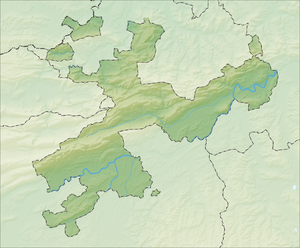Neu-Thierstein Castle
| Neu-Thierstein Castle | ||
|---|---|---|
|
Neu-Thierstein |
||
| Alternative name (s): | Thierstein Castle | |
| Creation time : | around 1180/1190 | |
| Castle type : | Höhenburg, spur location | |
| Conservation status: | ruin | |
| Place: | Büsserach | |
| Geographical location | 47 ° 23 '5.8 " N , 7 ° 32' 17.6" O | |
|
|
||
The Neu-Thierstein Castle , also known as Castle Thierstein referred, which is ruin a Spur castle between Büsserach and Erschwil in District Thierstein , Canton Solothurn , Switzerland . It is considered a landmark of the Lüsseltal and the Schwarzbubenland . The castle stands on a rock spur on the floor of the municipality of Büsserach.
history
The castle was founded around 1100 by the Counts of Saugern-Pfeffingen as a castvogtei seat together with the Beinwil monastery and was initially called Bello . According to written records, it was assumed that it was built around 1180/1190, when Count Rudolf von Thierstein inherited the Counts of Suckers in the middle and lower Birstal . In any case, the Counts of Thierstein took over the castle together with the Kastvogtei. A new building was built around 1294/95.
The Counts of Thierstein divided into two lines after 1350, one taking over the Farnsburg and the other Pfeffingen . Neu-Thierstein fell to the Pfeffingers, who mostly lived on Pfeffingen and pledged Neu-Thierstein (the name Thierstein is documented in 1400) several times. The Solothurnians occupied Neu-Thierstein in 1445 (after the battle of St. Jakob ), in 1467 and in the Swabian War in 1499; They finally acquired the castle in 1522 after the Counts of Thierstein had died out with Heinrich's death .
From then on Neu-Thierstein was the seat of the Solothurn Bailiwick Thierstein. After the proclamation of the Helvetic Republic in 1798, the castle was auctioned for demolition, but in the 19th century private individuals saved it from further destruction. Since 1894 it was owned by the Basel section of the Swiss Alpine Club SAC, which set up a clubhouse in it. In 1985 construction studies and soundings were carried out.
Redevelopment
On March 2, 1997, part of the ruins collapsed unexpectedly, with the Passwangstrasse being buried by around 20 m 3 of rock. After the collapse, the municipality of Büsserach bought the ruin from the SAC for 25,000 Swiss francs . The collapsed southwest corner was then rebuilt in concrete. Overall, the renovation costs amounted to a good 2 million francs, in which the Confederation and the Canton of Solothurn contributed 884,000 francs. A portion of 330,000 CHF was covered by donations.
literature
- Werner Meyer : Castles from A to Z - Burgenlexikon der Regio . Published by the Castle Friends of both Basels on the occasion of their 50th anniversary. Klingental printing works, Basel 1981, pp. 213–215.
Web links
- Werner Meyer: Neu-Thierstein. In: Historical Lexicon of Switzerland .
- Castle world: Neu-Thierstein Castle
Individual evidence
- ↑ a b Neu-Thierstein Castle . In: myswitzerland.com . Switzerland tourism. Archived from the original on February 3, 2014. Retrieved May 15, 2017.
- ↑ a b c d e f g Werner Meyer: Neu-Thierstein. In: Historical Lexicon of Switzerland .
- ↑ a b Werner Meyer: Burgen A to Z . Castle lexicon of the region. Ed .: Friends of both Basel castles. Klingental printing works, Basel 1981, p. 214 .
- ↑ a b Werner Meyer: Burgen A to Z . Castle lexicon of the region. Ed .: Friends of both Basel castles. Klingental printing works, Basel 1981, p. 215 .
- ^ A b Samuel Rutishauser: Demolition or Reconstruction? The partial collapse of the Neu-Thierstein castle ruins in Büsserach SO [Abstract ] . baufachinformation.de. 2005. Retrieved April 11, 2010.
- ^ Ag .: Briefly noted: The lock slipped . In: Tages-Anzeiger . March 3, 1997.
- ↑ 150 years of district school Thierstein-West: Büsserach . Retrieved April 11, 2010.
- ^ Büsserach community: community news and photos archive . September 9, 2002. Archived from the original on October 15, 2010. Retrieved on August 24, 2012.



